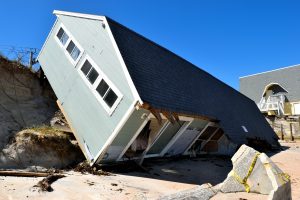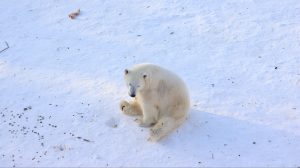Chapter 8: Climate Change
Tai Munro
Key Ideas
In this chapter, you will learn about:
- the basics of what climate change is
- climate change and feedback loops
- research about how people see themselves in climate change
What is Climate Change: A Brief Overview
Climate change and global warming are terms that get thrown around a lot in society today, but what do they actually mean? Global warming was the first term popularized to describe the changes happening to the Earth’s climate. Through industrialization and new technologies, humans began to unlock energy stored in the past. Up until this point, we could only operate with the energy from current or recent sunlight. We could cut down trees and burn the wood to release the energy the plants had stored from the sun. But this was all on a fairly recent time scale. With the advent of technologies that extracted and burned fossil fuels, we could access the energy stored from ancient sunlight. This was great for productivity because we didn’t have to wait for new trees to grow. But when we burn things, we release the gas carbon dioxide. By burning fossil fuels, we were releasing much more carbon than we had previously. The carbon, in the form of carbon dioxide, builds up in the atmosphere, where it stops heat from leaving the Earth. Think of it like a blanket wrapped around the Earth to keep the heat in. Global warming describes the overall heating of the planet, but it doesn’t capture all the other changes that happen as a result. That’s where the term climate change comes in. The overall push on the climate is the increased temperature, but this doesn’t play out the same way everywhere. Some places end up colder, and we get more extreme weather, so things like massive storms, floods, and droughts all happen more frequently, and the seasons are shifting in many places, with spring often starting earlier than it used to. Climate change refers to these more general changes in an attempt to capture the breadth of the consequences of putting more carbon dioxide and other greenhouse gases into the atmosphere.
Recommended Resource
Check out the TEDEd video (2:49) Climate change: Earth’s giant game of Tetris developed by Joss Fong to learn more about how climate change works.
If you would like to learn more, we also recommend:
- How Do Greenhouse Gases Actually Work? (3:08) by MinuteEarth
- David Spiegelhalter: Why is Probability Difficult and Unintuitive? (1:44) published by Wired UK
The video on probability is interesting because it gives some insight into why it is so difficult to understand and sometimes accept climate change.
Feedback Loops
Climate change is an area where we see feedback loops in action. In fact, it is the feedback loops that create some of the challenges and unknowns with climate change. Because our global climate is a system, many interconnections and relationships exist. But, as you have seen, sometimes our actions have unintended consequences. The climate isn’t directly determined by how many parts per million of greenhouse gases are in the atmosphere. That is part of the equation, but other factors, like how reflective the Earth’s surface is, also impact it. You have probably heard that wearing dark-coloured clothing on a sunny day will make you warmer. This is because dark colours absorb more sunlight compared to light colours. The same thing happens with our planet. When we have lots of ice, the ice reflects the sun’s heat away. But as climate change causes sea ice to melt, we lower the reflectivity of the earth’s surface. As a result, the Earth absorbs more heat, which then causes more melting.
Recommended Resource
Feedback loops are a significant part of climate change. We can’t identify the action level needed without considering the feedback loops. The following resource illustrates four major feedback loops that impact climate change. If you want to know more about climate change or if you would like more information about feedback loops, this is a helpful resource: Climate Emergency: Feedback Loops.
Global Initiatives
In Chapter 7, we briefly mentioned global initiatives in addition to the UN SDGs. You may have noticed that several of them focused on climate change. The IPCC reports provide a basis for many other climate change initiatives. The IPCC aims to objectively analyze the existing scientific, technical, and socio-economic knowledge about climate change. One of the ways that they do this is by ensuring diversity and representation among the authors of the various reports. Remember that systems thinking is best done by a diverse group of people. Everyone has their own biases and perspectives, but by combining many different perspectives, we can work to overcome biases. Therefore, ensuring diverse representation is important to completing an objective analysis. At the same time, there will always be voices that are missing. The IPCC relies on all authors completing the work voluntarily. As a result, most, if not all, authors will be employed by an organization that would support their participation as part of their job. This has the potential to exclude some individuals.
Activity 8.1: What Do You Want Someone Else to Know?
There is a lot to unpack in the IPCC reports. Fortunately, there are organizations that help to break down the information in these reports. Check out CarbonBrief’s resources on the IPCC sixth assessment cycle. Choose a resource from the list on a topic that interests you and consider the following:
- Why is your chosen topic relevant to you and/or your discipline?
- What surprised you about what you learned?
- What would you want someone else to know about the topic?
Create a social media post or infographic that informs someone else about what you think is the most interesting or important information from the resource.
Visualizing Climate Change
What do you think of when you think about climate change? Are there any pictures that come to mind?



The images can seem quite distant and separate from our everyday lives. This can make it challenging for us to respond with any urgency. For her doctoral research, Dr. Tai Munro worked with a group of outdoor educators to explore how they might visualize climate change in their personal contexts. Watch the next video to learn more.
Reflection 8.1: How Would You Picture Climate Change?
As you move through your life for the next few days, think about how the participants in the research study ended up relating to climate change. Do you see any symptoms or causes of climate change in your daily life? What photos would you take?
Expanding Your Knowledge
Climate change impacts many aspects of our personal and professional lives, whether we realize it or not. From insurance rates to fiction to systemic racism, climate change is part of the story. If you think back to systems thinking, we saw how different parts of our world are interconnected in important ways that impact how systems behave. How is climate change connected to the parts of your system?
Activity 8.2: Expanding Your Knowledge
Conduct an online search to find two to three resources that connect climate change to a field you are interested in. Then create or find an image that you could use to help explain the main points of the resources to someone. Some potential resources include:
- “How Extreme Weather is Shrinking the Planet” by Bill McKibben
- “Black Lives Matter and the Climate” in How to Save a Planet
- “War vs Climate” in Energy vs Climate
- “How Climate Change is Disrupting the Global Supply Chain” by Jacques Leslie
Activity 8.3: Can You Save the Planet?
Access The Climate Game created by The Financial Times. Complete the activity and write up a summary and reflection that includes:
- Which advisor did you choose? Why do you think that approach would be the most likely to achieve the goal?
- What was your end result? How much warming occurred, etc.
- What were your biggest limiting factors when making your decisions and why? What, if anything, did you do to overcome the limiting factors?
- What are the benefits of activities like these for combatting climate change?
- What are the limitations of activities like these for combatting climate change?

